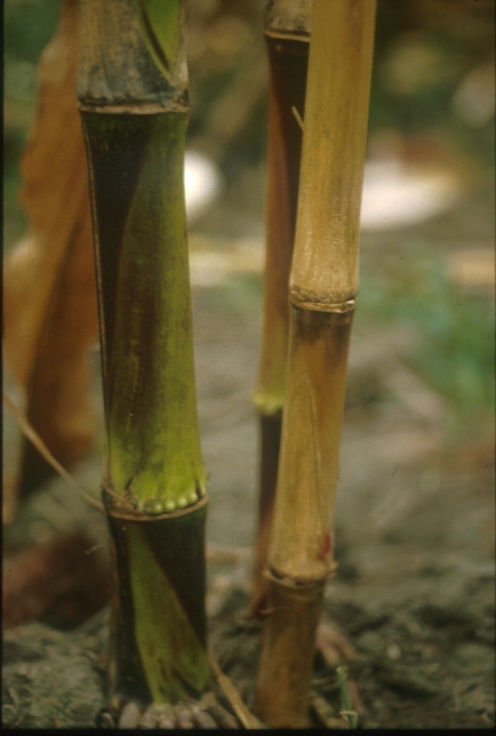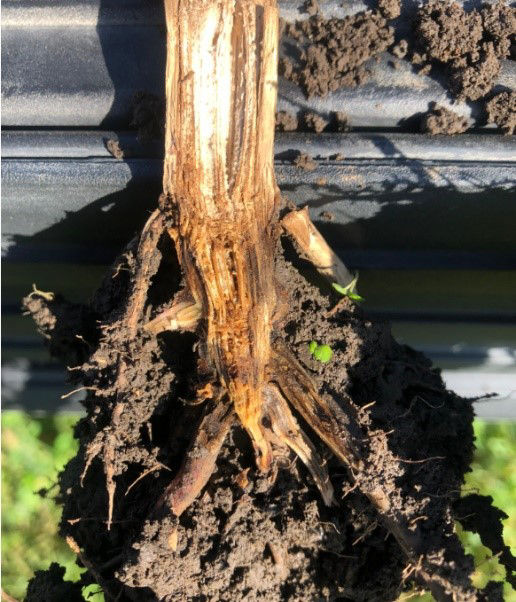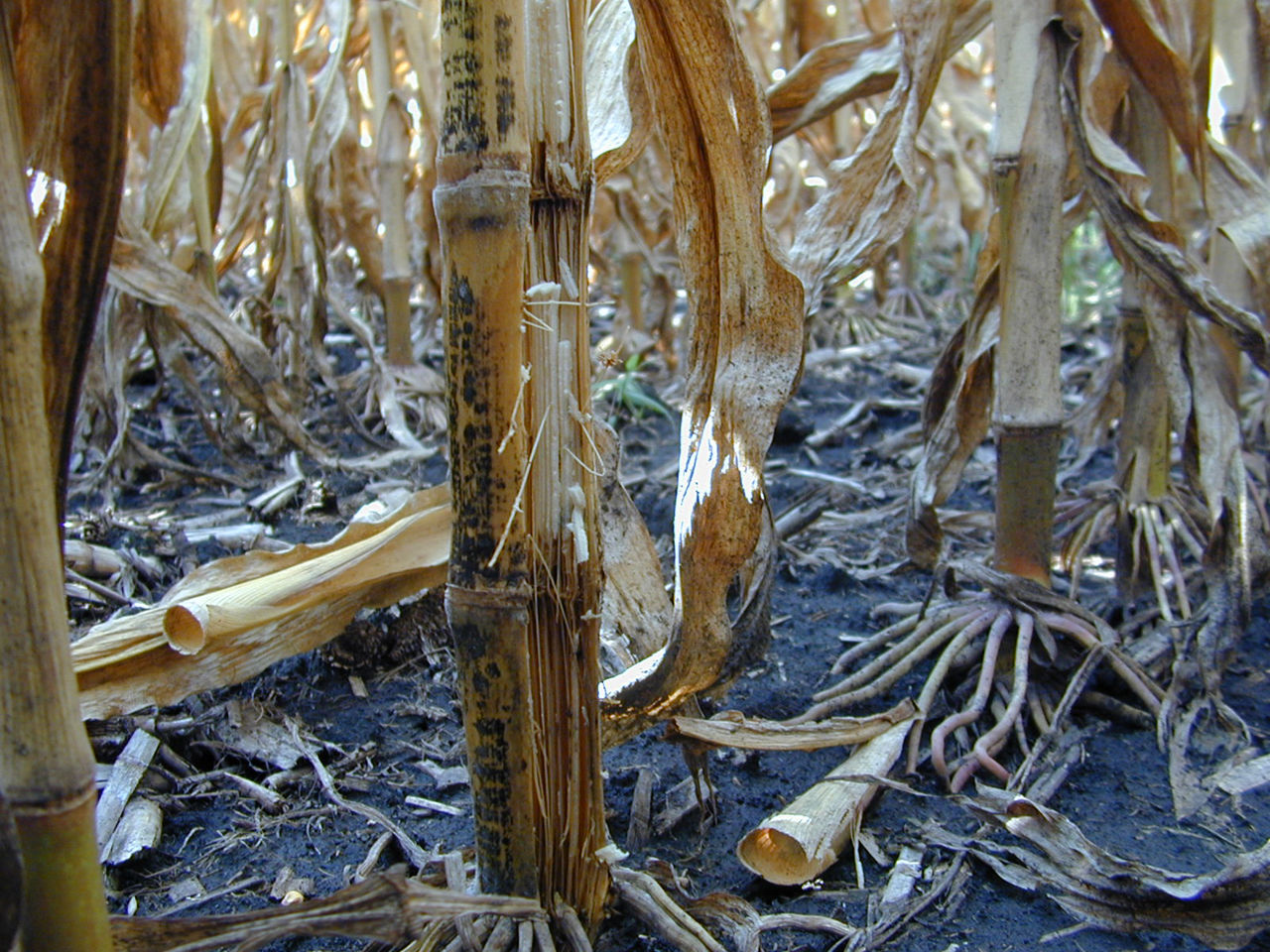Crown Rot in Corn
November 9, 2022
Early-season seedling diseases can cause stalk rot issues in corn fields. Fields that endured wet growing conditions in the spring have an increased chance of Fusarium species infection which can develop into crown rot and lead to stalk lodging.
Disease Development and Symptoms
Crown rot infections are usually caused by Fusarium species; however, the fungus that causes anthracnose (Colletotrichum graminicola) may also be a factor. Infections may be observed in seedling growth stages or can begin to appear around silking and tasseling. Noticeable symptoms sometimes begin with the senescence (firing) of lower leaves, which then progress upward on the plant (Figure 1). While the tissue inside the crown and stalk (the pith) of a healthy plant should be white in color, a tan-to-brown color within the crown is observed with a Fusarium infection. The discoloration is affected by the level of infection. More severe infections are darker brown, and the crown tissue can become extensively rotted. If the presence of dead leaves is observed, be sure to split the stalks, especially below the soil line into the root zone to check for crown rot or discoloration. Severe infections disrupt the flow of water and nutrients in the xylem (vascular) tissue and may cause stunting, leaf yellowing, wilting, and even death. Stalk cannibalization occurs when the corn plant is not able to complete ear fill without remobilizing nutrients and energy from lower leaves and stalks to meet the demand from the developing kernels. This may appear as the pith being shredded and discolored, giving the stalk a hollow appearance (Figure 2). The internodes of severely infected stalks can be easily pinched by hand. Dead plants (sometimes referred to as “ghosted” plants) can occur in patches, or as a single random plant.


The stress of excessively wet soils in the spring can be conducive for disease infection. Other stresses may include cold temperatures, soil compaction, fertility issues, or herbicide injury. In some years, the stress combination of a wet spring followed by an extended dry period can lead to crown rot infection.
A similar disease, Physoderma (Physoderma maydis) node or stalk rot, can be confused with crown rot as the symptoms are very similar. Infected plants often grow well without any noticeable impact on ear or kernel size. Generally, losses are related to lodging.
Harvest Concerns & Yield Impact
While crown rot infections have their beginnings in early-season plant infections, they can persist much longer, eventually resulting in stalk rot and potential yield loss.A crown rot infection that results in stalk rot may also lead to lodging. Typical symptoms of Fusarium stalk rot include whitish-pink to salmon discoloration of tissue at the nodes, while plants infected with anthracnose tend to have shiny black blotches or streaks on the outer stalk. Fields should be monitored closely to schedule harvest while there is still enough stalk strength left to help facilitate harvest.
Fields with considerable lodging should be harvested early to minimize the risk of additional lodging. Although drying cost is a concern when harvesting wet grain, this expense will likely be a better option compared to potential yield loss from lodging.
Test weights may be lighter due to the impact from crown rot and/or lodging on the ability of corn to finish transporting adequate carbohydrates to the kernel.
Fields with considerable lodging should be harvested early to minimize the risk of increased lodging. Although drying cost is a concern when harvesting wet grain, this expense may be a better option compared to potential yield loss from lodging. Test weights may be lighter due to the impact from crown rot and/or lodging on the ability of corn to finish transporting carbohydrates to the kernel.
Disease Management
Fusarium is a pathogen commonly found in crop residue and soil. Resistance to Fusarium crown rot is not available in current corn products, although growers might observe different levels of infection among various products grown in the same field. Fungicide seed treatments are available with protection against Fusarium; however, the treatment does not persist long enough to protect corn from crown rot. Because crown rot is associated with various stresses in addition to fungal infection, identifying and alleviating any stresses may help reduce loss from Fusarium crown rot. For example, early-season plants that are stunted with crowns that are not completely discolored and rotted may benefit from cultivation. Bringing the soil up around the crown may promote nodal root development and help plants recover. Use residue breakdown tactics, such chopping or incorporating to help reduce stalk-borne residue. Follow agronomic recommendations for plant populations, as it can help reduce stress associated with high populations.
Sources
1Munkvold, G. 2002. Crown rot symptoms common in corn. Integrated Crop Management. IC-488(15). Iowa State University Extension. https://dr.lib.iastate.edu/server/api/core/bitstreams/277b378e-a22c-4a9c-83a3-eb6dcdf6d943/content/.
2Jackson-Ziems, T. 2015. Stalk and crown rot diseases developing in some corn. CROPWATCH. University of Nebraska-Lincoln Extension. https://cropwatch.unl.edu/stalk-and-crown-rot-diseases-developing-some-corn/.
3Munkvold, G. 2001. Crown rot affecting corn development. Integrated Crop Management. IC-486(18). Iowa State University Extension. https://dr.lib.iastate.edu/server/api/core/bitstreams/b6f25191-7ac1-447a-b595-913bd383538d/content/.
1211_58016
